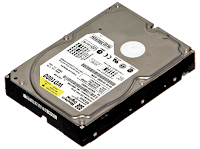Here are the most common parts of a computer, their use and tips on what to get.
1) Monitor
- This is an output device for display.
- It can either be those bulky CRTs (Cathode Ray Tube) or sleek LCD screens.
- CRTs are no advisable not just because of the size they take but because they consume higher power compared to an LCD screen.
- If you buy an LCD screen you might want to consider getting LED LCD because it will consume even half of what an LCD will consume.
 |
| CRT Monitor |
 |
| LCD Monitor |
2) Motherboard
- This is the part of the computer where everything is placed or connected to. It holds the slots and ports where the other parts will be attached.
- When upgrading or buying a motherboard make sure it contains the most recent slots and ports to ensure that you will not limited in the kind of parts you install into it.
- Example there are two kinds of ports for a CD/DVD drive and hard disk drive. It can be the earlier IDE or a SATA port. Some motherboards can carry both IDE and SATA during the period where SATA is still new.

3) Processor
- This is the "brain" of the computer because it does necessary computations and logical operations to run a program.
- At the moment of writing the most known processors brands are Intel and AMD. Based on what I have read from forums Intel are best for office and desktop publishing work while AMD is best for gaming.
- When buying a processor don't just be taken by the numbers. Try to ask when the processors came out and do use the internet to review about the processor of your choices.
- When you buy the processor it comes with a standard fan but if you are thinking of overclocking or exceeding the use of your processor more than its intended speed then you might want to invest on a branded fan.


4) RAM
- This means Random Access Memory and is responsible for becoming temporary storage for use by actively running programs and processes of a computer.
- generally the higher the RAM the more programs you can run at the same time but the processor would play a big part two in determining if these programs will run smoothly.
- If you are buying a new computer I highly suggest that nowadays don't settle for anything less than 2GB of RAM anymore and make sure to stay away from SDRAM, DDR and DDR2 as these are old models already.
- RAM comes in sizes of 512kb, 1GB, 2GB, 4GB and 8GB. Usually there are only two slots available so if you hear that they are selling a computer with 3GB of RAM then it is most likely composed on a 2GB and 1GB sticks of RAM.
- typically a laptop RAM would come also in smaller size.
5) Hard Disk Drive
- The programs, files and pictures are stored in a hard disk drive.
- It comes in either with a SATA port or an IDE port, the latter being the older model.
- SATA allows much higher capacity of data that can be transferred with also a much slimmer cables to be used.
- Desktop hard disk drives are about 3.5 inches while laptop hard disk drives are 2.5 inches.
- It comes in storage sizes of 80GB, 120GB, 160GB, 240GB, 320GB, 640GB, 1TB, 2TB, 3TB etc. My best suggestion is get at least a 320GB minimum to assure that you don't have to worry much about storage space anymore. However if you don't plan of saving lots of picture or movies then 240GB is quite sufficient.
- Please note that if you get a 640GB it doesn't equally mean to be 640GB exactly. It may fall off a few kilobytes because the conversion is not exact. 1024 bytes = 1kilobytes (KB), 1024 KB = 1 Megabyte (MB), 1024 MB = 1 Terabyte (TB), 1024 TB = 1 Gigabyte (GB).
6) CD / DVD Drive
- This is where you put your CDs and DVDs so you can view their content inside the computer.
- If you get one with a write feature it can also be used to back-up or save data from your computer into a CD / DVD. The CD and DVD you must though must also be Writable.
- Like the hard disk drive it can also be either for a SATA or IDE port, the latter being the older model.
- A desktop can carry as many as 3 CD-DVD drives at the same time depending on the number of bays which can be carried by the case used however for a laptop there is only one CD-DVD drive available, sometimes none at all like with netbooks.
 |
| Internal CD/DVD drive |
 |
| External CD/DVD drive |
7) Video Card
- They are expansion cards which allows to creates the images to be displayed out to the monitor.
- Motherboards nowadays have their on-board video and this would share memory from the RAM but some more advanced boards would have their dedicated memory even if it is on-board specially with laptops.
- You may consider using a video card instead of an on-board video if you wish to run more power hungry graphics like for computer games and multimedia editing.
- Be careful not just to buy any kind of video card and always check what your motherboard can handle are there now several lots types for use on video cards. The latest now are PCIe.




0 comments:
Post a Comment